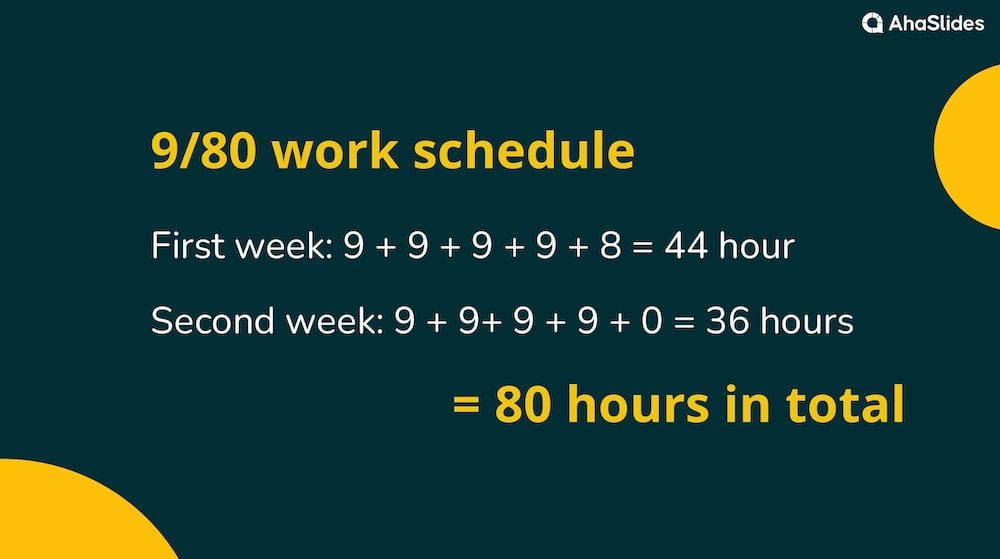Haben Sie auch schon einmal das Gefühl gehabt, dass der klassische 9-bis-5-Arbeitsplan heutzutage einfach zu langweilig und einschränkend ist? Damit sind Sie nicht allein – viele Menschen meinen, es sei Zeit für etwas Neues.
Dies wird immer mehr Unternehmen bewusst, die beginnen, Alternativen zum normalen 9-bis-5-Arbeitsalltag anzubieten.
Eine Option, die immer beliebter wird, ist die 80/9-Arbeitsregelung.
Sie sind sich nicht sicher, ob es zu Ihnen oder Ihrem Team passt? Keine Sorge, wir erklären Ihnen alles.
Wir erklären Ihnen genau, wie die 9-80 Arbeitsplan Arbeiten, die Vor- und Nachteile für Arbeitnehmer und Arbeitgeber und ob es gut zu Ihrem Unternehmen passen könnte.
Inhaltsverzeichnis
- Was ist ein 9-80-Arbeitsplan?
- Was ist ein Beispiel für einen 80-9-Arbeitsplan?
- Was sind die Vorteile eines 9-80-Arbeitsplans?
- Mögliche Nachteile eines 9-80-Arbeitsplans
- Key Take Away
- Häufig gestellte Fragen (FAQ)
Tipps für besseres Engagement

Auf der Suche nach mehr Spaß bei Versammlungen?
Bringen Sie Ihre Teammitglieder mit einem unterhaltsamen Quiz auf AhaSlides zusammen. Melden Sie sich an, um am kostenlosen Quiz aus der AhaSlides-Vorlagenbibliothek teilzunehmen!
🚀 Holen Sie sich ein kostenloses Quiz ☁️
Was ist ein 9-80-Arbeitsplan?
Ein 9/80-Arbeitsplan ist eine Alternative dazu traditionell 9-5, Fünf-Tage-Woche, bei der Sie, anstatt 8 Stunden am Tag von Montag bis Freitag zu arbeiten 9 Stunden am Tag arbeiten während einer zweiwöchigen Arbeitszeit.
Dies ergibt alle zwei Wochen 80 Stunden (9 Tage x 9 Stunden = 81 Stunden, minus 1 Stunde Überstunden).
Du hast jeden zweiten Freitag als deinen frei flexibler TagSie arbeiten also in einer Woche von Montag bis Donnerstag und in der nächsten von Montag bis Freitag.
Dadurch haben Sie alle zwei Wochen ein dreitägiges Wochenende, sodass Sie effektiv mehr frei haben, ohne Urlaubstage in Anspruch nehmen zu müssen.
Ihr Zeitplan ist normalerweise so eingerichtet, dass Ihr flexibler Tag in jeder Zahlungsperiode auf denselben Tag fällt. Dadurch bleibt die Konsistenz erhalten.
Die Zeitmessung folgt weiterhin dem Standard 40-Stunden-Woche Regeln zur Überstundenvergütung. Alles über 8 Stunden am Tag oder 80 Stunden in einem Lohnzeitraum löst OT aus.

Was ist ein Beispiel für einen 80/9-Arbeitsplan?
Hier ist ein Beispiel dafür, wie der 9/80-Arbeitsplan mit einer einstündigen Mittagspause pro Tag aussieht:
| Woche 1 | Woche 2 |
| Montag 8: 00 - 6: 00 Dienstag 8: 00 - 6: 00 Mittwoch 8: 00 - 6: 00 Donnerstag 8: 00 - 6: 00 Freitag 8: 00 - 5: 00 | Montag 8: 00 - 6: 00 Dienstag 8: 00 - 6: 00 Mittwoch 8: 00 - 6: 00 Donnerstag 8: 00 - 6: 00 Freitag freier Tag |
Zu den gängigen Branchen, in denen der 9-80-Arbeitsplan gilt, gehören:
Regierungsbüros – Bundes-, Landes- und lokale Behörden bieten ihren Mitarbeitern häufig 9-80-Stunden-Arbeit an. Dazu gehören beispielsweise DMVs, Postdienste und öffentliche Bauämter.
Gesundheitswesen Krankenhäuser wünschen sich eine siebentägige Betreuung, die rotierenden freien Freitage tragen dazu bei. Auch Büroangestellte wie Kliniken und Labore nutzen diese Option.
Versorgungsunternehmen – Orte wie Wasseraufbereitungsanlagen, Energieunternehmen usw. müssen ständig überwacht werden, daher verbessert der Zeitplan die Abdeckung.
Fertigung – Bei Produktionshallen, die rund um die Uhr in Betrieb sind, trägt 24/7 dazu bei, eine angemessene Personalbesetzung über alle Schichten hinweg sicherzustellen und gleichzeitig Flexibilität zu gewährleisten.
Call Center – Kundendienstrollen lassen sich gut in den Zeitplan integrieren, da die Wartezeiten durch versetzte Wochenenden gering bleiben.
Strafverfolgung – Polizeistationen, Gefängnisse und Gerichtsgebäude haben es frühzeitig eingeführt, um es an die Betriebszeiten anzupassen.
Einzelhandel – Geschäfte, die am Wochenende geöffnet sind, betrachten dies als Anreiz zur Mitarbeiterbindung für Vollzeitmitarbeiter.
Transport – Alles von Fluggesellschaften über Frachtunternehmen bis hin zur Kraftfahrzeugbehörde.
Technologie – Startups und Technologieunternehmen möchten möglicherweise diesen Arbeitsplan übernehmen, um die Flexibilität zu erhöhen und Talente anzuziehen.
Was sind die Vorteile eines 9-80-Arbeitsplans?
Lässt sich eine Arbeitszeit von 9 bis 80 Uhr in Ihrem Unternehmen umsetzen? Berücksichtigen Sie diese Vorteile, um zu entscheiden, ob sie für Sie geeignet ist:
Für die Mitarbeiter

- Jeden zweiten Freitag frei – Dieser zweiwöchentliche Plan gibt den Mitarbeitern jede zweite Woche einen zusätzlichen halben freien Tag, was im Wesentlichen einen zusätzlichen freien Tag pro Lohnperiode bedeutet. Dies ermöglicht dreitägige Wochenenden oder eine Pause unter der Woche.
- 40-Stunden-Woche – Mitarbeiter arbeiten innerhalb der zweiwöchigen Arbeitszeit 80 Stunden, sodass keine bezahlten Stunden verloren gehen. Dies trägt zu einer ausgewogenen Work-Life-Balance bei.
- Flexibilität – Der Zeitplan bietet mehr Flexibilität als ein herkömmlicher Montag-Freitag-Zeitplan. Mitarbeiter können an ihren freien Freitagen Termine vereinbaren oder persönliche Angelegenheiten regeln, ohne bezahlten Urlaub zu benötigen.
- Reduzierte Pendelkosten – Da Mitarbeiter jeden zweiten Freitag frei haben, sparen sie jede zweite Woche Benzin und Fahrtkosten. Dies kann ihre monatlichen Ausgaben senken.
- Erhöhte Produktivität – Einige Studien zeigen Ein flexibler Zeitplan führt zu einer höheren Arbeitszufriedenheit und weniger Burnout, was das Engagement und die Produktivität der Mitarbeiter steigern kann.
- Mehr Zeit für einen Teilzeitjob – Obwohl wir es nicht empfehlen, da es die geistige und körperliche Gesundheit beeinträchtigen kann, bietet der zusätzliche freie Tag manchen die Möglichkeit, einen Nebenjob oder eine Teilzeitarbeit anzunehmen, um zusätzliches Einkommen zu erzielen.
Für die Arbeitgeber

- Höhere Produktivität – Studien zeigen, dass der Zeitplan Stress und Burnout reduzieren und so zu einer höheren Arbeitsqualität führen kann. Mitarbeiter sind möglicherweise konzentrierter und engagierter.
- Geringere Gemeinkosten – Büros können jeden zweiten Freitag geschlossen bleiben, wodurch an diesem halben Tag in der Woche Nebenkosten, Wartungskosten und andere Gemeinkosten eingespart werden.
- Talente gewinnen und halten – Es verschafft dem Unternehmen einen Vorteil bei der Rekrutierung und Bindung von Spitzenkräften, die Wert auf Flexibilität am Arbeitsplatz legen.
- Verbesserter Kundenservice – Durch die Aufrechterhaltung der Abdeckung für zusätzliche Stunden können Kunden während der gesamten Arbeitswoche betreut oder Termine/Anrufe bearbeitet werden.
- Zeitliche Flexibilität – Manager haben die Flexibilität, Projekte oder Aufgaben während der gesamten Arbeitszeit eines jeden Tages angemessen zu besetzen.
- Weniger Fehlzeiten – Mitarbeiter werden wahrscheinlich weniger Krankheitstage oder ungeplante Freizeit in Anspruch nehmen, da sie anderweitig zusätzliche Zeit einplanen können.
- Steigerung der Moral und Zusammenarbeit – Eine durch den Zeitplan gesteigerte Arbeitszufriedenheit führt zu einer besseren Unternehmenskultur und besseren Beziehungen zwischen den Abteilungen.
Mögliche Nachteile eines 9-80-Arbeitsplans

Bevor Sie vorschnell die Richtlinien ändern, müssen Sie die Kehrseite dieses besonderen Arbeitsplans bedenken, beispielsweise:
- Administrative Komplexität – Es erfordert mehr Koordination und Planung, um täglich eine angemessene Abdeckung aller Abteilungen sicherzustellen.
- Möglicher Personalmangel – An den längeren Arbeitstagen oder den „freien“ Freitagen steht für einige Rollen möglicherweise nicht genügend Personal zur Verfügung.
- Überstundenkosten – Mitarbeiter, die an ihren geplanten längeren Arbeitstagen mehr als 8 Stunden arbeiten, haben Anspruch auf Überstundenvergütung.
- Inflexibilität – Der Zeitplan ist starr und erlaubt keine einfache Änderung der Tage/Stunden bei sich ändernden Anforderungen. Passt möglicherweise nicht zu allen Rollen.
- Arbeitszeiterfassung – Für Manager und Lohnbuchhalter ist es schwieriger, die Arbeitszeiten bei einer atypischen Arbeitswoche genau zu erfassen. Eine strukturierte Implementierung mit einem Zeitplan für die Anmeldung und einer Übergangsphase für Koordination und Kommunikation ist wichtig.
- Missverständnisse – Wenn sich die Personalverfügbarkeit alle zwei Wochen ändert, besteht ein erhöhtes Risiko für Missverständnisse.
- Beeinträchtigt die Zusammenarbeit – Unterschiedliche Arbeitszeiten in den Teams können sich negativ auf die Zusammenarbeit und Gruppenarbeit auswirken.
- Ungleichgewichte – Nicht alle Jobs oder Funktionen sind für den Zeitplan geeignet, was zu Ungleichgewichten zwischen den Rollen führt. Einige Bereiche wie Kundenservice, Gesundheitswesen oder Schichtarbeit bieten möglicherweise keine Flexibilität bei der Arbeitszeitgestaltung.
- Unausgewogene Arbeitsbelastung – Die Arbeit kann im zweiwöchigen Zeitplan ungleichmäßig verteilt sein.
- Integrationsprobleme – Für 9/80-Mitarbeiter kann es eine Herausforderung sein, sich effektiv mit Partnern auf Grundlage eines standardmäßigen MF-Zeitplans abzustimmen.
Key Take Away
Der Arbeitszeitplan von 9 bis 80 Uhr sorgt für mehr Freizeit ohne Lohnkürzungen oder Arbeitszeiterhöhungen und bietet gleichzeitig ein hohes Maß an Flexibilität.
Bei richtiger Planung bietet es viele Vorteile, passt aber möglicherweise nicht zu allen Branchen oder Unternehmenskulturen/Kommunikationspräferenzen.
Für die Aufrechterhaltung eines reibungslosen Arbeitsablaufs ist die Schulung zu Zeitplanspezifika wie Zeiterfassung, Anwesenheitsregeln und Koordination mit Kollegen mit regulären Dienstplänen von entscheidender Bedeutung.
Trainieren Sie effektiv, wann und wo immer Sie sindNeue Richtlinien brauchen Zeit, um angenommen zu werden. Kommunizieren Sie Ihre Informationen klar mit ansprechenden Umfragen und Fragen und Antworten.
Häufig gestellte Fragen (FAQ)
Wie viele Stunden hat ein 9/80-Plan pro Woche?
Bei einem 9/80-Arbeitsplan arbeiten die Mitarbeiter 9 Stunden pro Tag über einen Zeitraum von 9 Tagen in einem zweiwöchigen Lohnzeitraum.
Was ist ein 3 12 Arbeitsplan?
Ein 3/12-Arbeitsplan bezieht sich auf eine Rotation, bei der Mitarbeiter an 12 Tagen pro Woche in 3-Stunden-Schichten arbeiten.
Was ist ein 9-80-Zeitplan in Texas?
Ein 9/80-Zeitplan funktioniert in Texas genauso wie in anderen Bundesstaaten. Arbeitgeber in Texas dürfen einen 9/80-Plan als flexible Arbeitsoption für ihre Mitarbeiter einführen, sofern die Überstundenregeln eingehalten werden.
Ist ein 9-80-Zeitplan in Kalifornien legal?
Arbeitgeber in Kalifornien dürfen alternative Arbeitswochenpläne wie 9/80 verwenden, sofern sie die Lohn- und Stundengesetze einhalten. Der Zeitplan muss in geheimer Abstimmung mit mindestens zwei Dritteln der betroffenen Mitarbeiter angenommen werden. Dies legitimiert die Fahrplanänderung.








